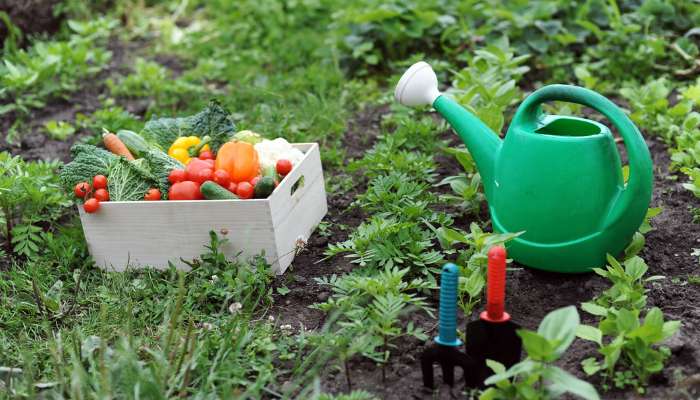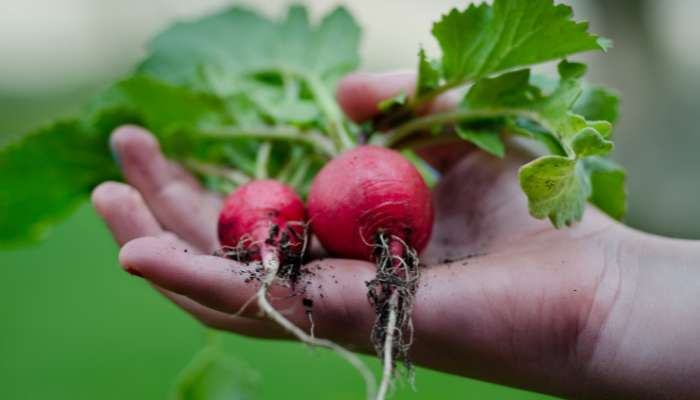Kitchen gardening, often hailed as a symbol of sustainable living, is a practice that brings the joy of gardening to your doorstep. It is a concept that transcends mere cultivation; It’s about developing a deep connection with nature, optimizing space, and reaping the rewards of indigenous goodness.
In this guide, we’ll explore the essence of kitchen gardening, its definition, benefits, and practical pointers for creating your own thriving kitchen garden oasis.
Kitchen Gardening Table of Contents
What is Kitchen Gardening?
Kitchen gardening is the art and science of cultivating edible plants, herbs, and vegetables for personal consumption, typically in small, accessible spaces such as backyards, balconies, or windowsills.
Unlike traditional ornamental gardens, which focus on aesthetics, kitchen gardens prioritize functionality, productivity, and sustainability. Here’s a closer look at the key aspects of kitchen gardening:
Diverse Plant Selection:
- Kitchen gardens boast a diverse array of edible plants, herbs, and vegetables chosen for their flavor, nutritional value, and culinary versatility.
- Common crops include tomatoes, lettuce, peppers, herbs like basil and parsley, root vegetables like carrots and radishes, and leafy greens like spinach and kale.
Intensive Planting Techniques:
- To maximize space and yield, kitchen gardens often employ intensive planting methods such as square foot gardening, intercropping, and companion planting.
- These techniques allow gardeners to grow more food in less space while minimizing competition for nutrients and water.
Seasonal Rotation:
- Kitchen gardens are planted on a seasonal basis, with crops rotated to optimize soil fertility and prevent pest and disease buildup.
- Rotating crops ensures a continuous harvest throughout the year and maintains a healthy, balanced garden ecosystem.
Close Proximity to the Home:
- One of the hallmarks of kitchen gardening is its proximity to the home, making it easy for gardeners to access and tend to their plants on a daily basis.
- Many kitchen gardens are located near the kitchen door or in containers on a patio or balcony, allowing for quick and convenient harvesting whenever fresh ingredients are needed for cooking.
Organic and Sustainable Practices:
- Kitchen gardeners often embrace organic and sustainable growing practices, such as composting, mulching, natural pest control, and water conservation.
- By avoiding synthetic pesticides and fertilizers, kitchen gardeners produce healthier, more flavorful produce while minimizing their environmental impact.

Benefits of Kitchen Gardening:
- Access to fresh, homegrown produce rich in flavor and nutrients.
- Satisfaction of growing your food and reducing reliance on store-bought produce.
- Connection with nature, seasons, and the cycle of life.
- Reduction of food miles and waste, leading to a more sustainable lifestyle.
Kitchen gardening is more than just a hobby; it’s a lifestyle choice that promotes self-sufficiency, environmental stewardship, and culinary creativity. By cultivating your own kitchen garden, you can enjoy the delights of fresh, homegrown produce while connecting with the natural world and reaping the rewards of your labor.
Whether you have a sprawling backyard or just a sunny windowsill, kitchen gardening offers a fulfilling and accessible way to nourish both body and soul. Start your kitchen gardening journey today and savor the abundant harvests that await you!
Getting Started: Essential Tools and Materials
Before embarking on your kitchen gardening journey, gather the following essentials:
Containers or Raised Beds
Choose containers or raised beds based on your available space and gardening goals. Options include pots, grow bags, wooden crates, or repurposed containers like buckets and barrels.
Quality Soil Mix
Invest in a well-draining soil mix rich in organic matter, such as compost or vermicompost. Good soil structure is essential for healthy root development and nutrient absorption.
Seeds or Seedlings
Select high-quality seeds or healthy seedlings from reputable sources. Consider factors like climate suitability, space requirements, and your personal preferences when choosing plant varieties.
Watering Can or Hose
Ensure access to water for regular irrigation. A watering can or hose with a gentle spray attachment is ideal for providing consistent moisture without causing soil compaction.
Gardening Tools
Basic tools like a trowel, hand fork, and pruning shears will aid in planting, weeding, and maintenance tasks. Invest in quality tools that are comfortable to use and durable.
Image | Product Name | Review | Price |
Choosing the Right Plants for Your Space
When selecting plants for your kitchen garden, consider the following factors:
Climate and Location
Choose plants that thrive in your local climate and sunlight conditions. Research the specific requirements of each crop to ensure successful growth and productivity.
Space Constraints
Opt for compact or dwarf varieties of vegetables and herbs if space is limited. Vertical gardening techniques, such as trellising or hanging baskets, can maximize vertical space and increase yield.
Seasonal Variability
Plan your garden layout according to seasonal changes and crop rotation principles. Sow seeds or transplant seedlings at the appropriate times to take advantage of favorable growing conditions.
Soil Preparation and Composting
Soil preparation is a critical step in establishing a productive kitchen garden. Follow these guidelines for optimal soil health:
Soil Testing
Conduct a soil test to assess nutrient levels, pH balance, and texture. Soil testing kits are available at garden centers or through agricultural extension services.
Soil Amendment
Amend the soil as needed based on the results of your soil test. Incorporate organic matter like compost, aged manure, or leaf mulch to improve soil structure and fertility.
Composting Basics
Start a compost pile or bin to recycle kitchen scraps, yard waste, and organic matter into nutrient-rich compost. Use compost as a natural soil conditioner and fertilizer for your garden beds.
Watering and Maintenance Tips
Proper watering and maintenance practices are essential for the health and productivity of your kitchen garden:
Watering Schedule
Establish a regular watering schedule based on the moisture needs of your plants and environmental conditions. Water deeply and consistently to promote strong root development and drought tolerance.
Mulching
Apply a layer of mulch, such as straw, shredded leaves, or grass clippings, around your plants to conserve soil moisture, suppress weeds, and regulate soil temperature.
Pruning and Thinning
Prune overcrowded or diseased plants to improve air circulation and sunlight penetration. Thin seedlings to maintain appropriate spacing and prevent competition for resources.
Dealing with Pests and Diseases
Despite your best efforts, pests and diseases may still affect your kitchen garden. Here are some eco-friendly methods for pest and disease management:
Natural Predators
Encourage beneficial insects, birds, and amphibians that prey on garden pests. Plant companion flowers and herbs that attract pollinators and pest predators, creating a balanced ecosystem.
Organic Pest Control
Use organic pest control methods such as neem oil, insecticidal soap, or homemade remedies like garlic spray and chili pepper repellent. Rotate crops and practice good sanitation to reduce pest pressure.
Disease Prevention
Practice good hygiene by removing diseased plant material and avoiding overhead watering to minimize fungal diseases. Choose disease-resistant plant varieties whenever possible and maintain proper spacing between plants.
Sure, here’s the FAQ section:
Frequently Asked Questions (FAQs)
What types of vegetables and herbs can I grow in a kitchen garden in India?
You can grow a wide variety of vegetables and herbs in your kitchen garden in India, including tomatoes, spinach, cucumbers, basil, mint, coriander, and chili peppers. Choose plants that are well-suited to your local climate and growing conditions.
How much space do I need to start a kitchen garden?
You don’t need a lot of space to start a kitchen garden. Even a small balcony, terrace, or windowsill can be transformed into a productive garden space. Utilize containers, raised beds, or vertical gardening techniques to maximize available space.
Is it necessary to use chemical fertilizers and pesticides in a kitchen garden?
No, it is not necessary to use chemical fertilizers and pesticides in a kitchen garden. Organic gardening methods, such as composting, crop rotation, and companion planting, can help maintain soil fertility and manage pests and diseases naturally.
How often should I water my kitchen garden?
The frequency of watering depends on factors such as weather conditions, soil type, and plant requirements. Generally, it’s best to water deeply and less frequently rather than shallowly and frequently. Monitor soil moisture levels and adjust your watering schedule accordingly.
Can I start a kitchen garden if I have limited gardening experience?
Absolutely! Kitchen gardening is suitable for beginners and experienced gardeners alike. Start small, choose easy-to-grow plants, and gradually expand your garden as you gain confidence and experience. Remember, gardening is a learning process, so don’t be afraid to experiment and make mistakes.





















1 thought on “Complete Guide Best Kitchen Gardening in India”